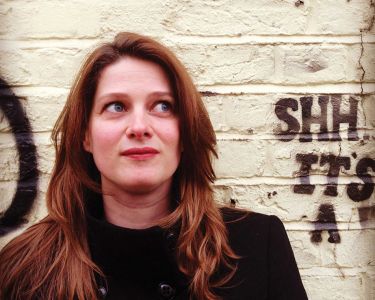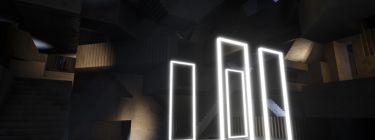
New Stages for Collective Imagination
Annette Mees, Artistic Director of Audience Labs, King’s College London and Creative Fellow at WIRED, London
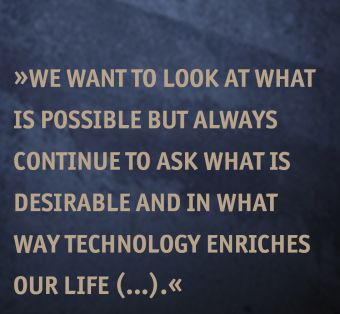
New Stages for Collective Imagination
The show must go on
Cultural institutions the world over collectively seek out new ways to connect meaningfully to local, global and diverse audiences—To co-produce and programme new kinds of experiences created with new kinds of creative teams and new kinds of partners offers exciting opportunities. Audiences are eager to connect with both big ideas and one another and have challenging and new experiences ahead. Audience Labs is an artist-led initiative looking at the intersection of Performance, Innovation and Social Change and was born at the Royal Opera House in London’s Covent Garden, a location with a centuries-old tradition of performance. Introducing the creative practices of opera and ballet to immersive technologies provided a unique opportunity to look at bringing human emotion and collective experiences together. We want to look at what is possible but always continue to ask what is desirable and in what way technology enriches our life in the wider societal shifts and upheavals of the digital and green transformations taking place before our eyes.
I’m a theatremaker not a technologist. I work in the arts because it has a public function—it’s a space to collectively reflect and imagine, a space that can help us explore what it means to be human in a future society and what it can contribute towards a next Renaissance. I’m interested in the artistic potential of technology and the role art and culture can play in shaping our relationship to the world, to each other and to the technologies we use in that process.
Picture above: Current, Rising CGI Production Shot House of Subconscious, Copyright: Joanna Scotcher & Figment Productions
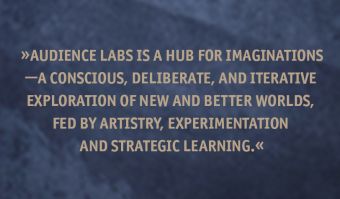
Current, Rising: an opera in hyper-reality
One of the projects Audience Labs presented in 2021 was Current, Rising. Described as the world’s first ‘hyperreal’ opera experience, it invites audiences to step into an atmospheric virtual world and take centre stage in the performance.
When I joined the Royal Opera House I was inspired by the ‘epicness’ of opera, the way the storytelling was driven by music first, narrative is secondary, the events are there to support the ideas and emotions. So many of them are about heightened emotions, to let you feel all the feels, so to speak, everything is bold and big. In opera the word Gesamtkunstwerk is used, or „all-embracing art form“.
Hyperreality combines Virtual Reality with a physical set and visceral effects like wind, heat, touch and movement to create a multi-sensory, immersive experience. It uses tracking to create a shared experience—the audience can see each other in the virtual space. It felt like an inherently operatic medium, which could enable audiences to step into an imaginative universe and to be the lead characters in it.
We wanted to do a project like this because it allowed us to use the possibilities of hyperreality to expand the idea of what an opera can be, both in the process of creation and in the audience experience. We set out to challenge the traditional hierarchies of opera and searched for different approaches to creating a 21st-century version of a Gesamtkunstwerk: A challenge and change of hierarchy to be found in many sectors, markets and communities now on their way to invent new sustainable and green ways of living and working. For us Current, Rising puts the opera as an institution right in the middle of these transformational debates about possible futures in Europe.
Fellow Travellers
Our starting point for projects is always identifying the most interesting questions—often that is a ‘What If’ question. The immediate second step is casting the right people to explore those questions with. Exploration and innovation is not something one does on one’s own. We believe that the power of creativity and innovation grows exponentially with the diversity and multiplicity present within a team. It is most powerful when based on a shared vision, shared vocabulary. When we visited Figment Productions, their technology and creative team felt like a perfect match. They had a radically different background from us, making work for theme parks and big live events, but they shared our enthusiasm for radical new ways of working, deepening the audience experience and doing everything with imagination. They, like us, were curious about the potential of a hyperreal opera and equally important brought a real sense of technological poetry to the table.
We brought together a highly-experienced and diverse creative opera team. We facilitated a series of sessions where we explored opera and hyperreality, finding directions of travel that might unlock something exciting. I call this establishing the artistic nucleus. Since we were not only inventing what a hyperreal opera might but also how we make it, we needed a space to develop a vocabulary before going into production. We gave makers time to develop attitudes and taste before landing on what they wanted to say on that particular stage; we enabled technologists to find artists that inspired and pushed them in new directions. It was the equivalent of making rough sketches before you decide what the painting looks like.
Picture right:
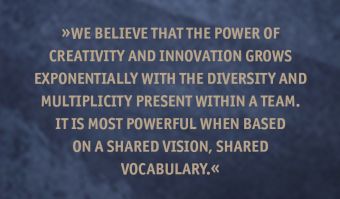
Iterate
Audience Labs embraced iterative working as a way to try out new ideas, and to de-risk investment and learning. When trying to create something both artistically valuable and highly innovative, you need time to fail and learn, reassess, make changes and try a different approach. Many projects start with an inkling of the possible but need time to gather the right ideas and the right team to work towards something that has meaning and value to an audience. Although an overemphasis on efficiency stifles innovation, iteration is simultaneously the most efficient way to look after your money. Innovation is inherently risky and unpredictable. But by working in stages, starting small and slowly scaling up to full production, you de-risk investment that is necessary for large-scale productions.
Current, Rising used techniques from theatre, technology and design to create a process that allowed the artistic and technological developments to iterate together towards a meaningful piece of work.
We started on paper, trying ideas and concepts out by making simple sketches, storyboards and mock ups. Some of the places we borrowed from included:Theatrical rehearsal and devising techniques
– Game design
– VR production pipeline
– Double diamond model
– Experience design
We shared work often and openly between the team until we knew we had the right story, technology, aesthetic and approach for the project to soar. Only then did we go into the full expensive production period. This approach allowed us to adapt to the complexities as the project grew and deliver an extraordinary project on a tight budget.
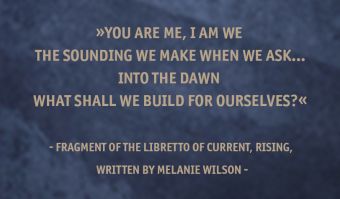
The show
The show that emerged from this process was Current, Rising. Inspired by the liberation of Ariel at the end of Shakespeare’s Tempest, Current, Rising takes four people at a time on a journey through the six phases of the night. Participants are empowered to collectively explore a series of imaginary dreamscapes, travelling from twilight to dawn as they encounter ideas of isolation, connection and re-imagination. It explores freedom as a process within our control, rather than as a state in which we exist, and asks how we might harness personal responsibility to join with others to re-think the future.
The audience enter a real life theatre set wearing VR headsets and go on a dreamlike journey carried musically by a poem layered in song. It takes the epic, music-driven and poetic qualities of opera and combines it with the possibility of VR to create any possible landscape, defying all natural laws, pushing beyond what is possible on the stage. In Current, Rising music, the visual world and the physical experience are completely enmeshed, changing the relationships between the creators, the usual sequence of creation, and the relationship of the audience to the work. Here the audience members are the protagonists: they are inside the work, and their physical experience is a part of the work itself.
The audience and the response
An audience research conducted by Royal Holloway discovered fascinating results.It brought new audiences to opera: 31% had not been to the Royal Opera House before and 68% of these new audiences were under 35.It also brought new audiences to the technology: 32% had not experienced virtual reality before. A lot of those were regular opera goers.
Many reported on a potent emotional experience, with uniformly high enjoyment ratings (an average of 4.6 out of 5) with an equally high rating in the seasoned opera goers and VR users and first timers. That cross-pollination of different audiences is really exciting—people who wouldn’t meet each other under different circumstances shared an experience in this show.
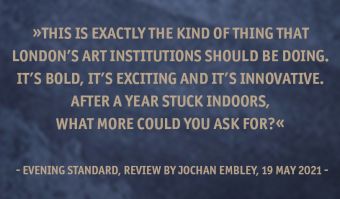
An audience research conducted by Royal Holloway discovered fascinating results.It brought new audiences to opera: 31% had not been to the Royal Opera House before and 68% of these new audiences were under 35.It also brought new audiences to the technology: 32% had not experienced virtual reality before. A lot of those were regular opera goers.
Many reported on a potent emotional experience, with uniformly high enjoyment ratings (an average of 4.6 out of 5) with an equally high rating in the seasoned opera goers and VR users and first timers. That cross-pollination of different audiences is really exciting—people who wouldn’t meet each other under different circumstances shared an experience in this show.
Possible futures through art
Current, Rising is one of many projects we developed at the Royal Opera House. In our three-and-a-half years there we worked with 22 partners and 44 artists spread over 14 countries. We explored a range of technologies including game engines, motion capture, animation, augmented reality and virtual reality and worked with artists working in opera and ballet, visual art, music, design, digital art, make-up and filmmaking. This convergence of perspectives, practises and ideas provided an incredibly fertile ground on which to create new ways of thinking about art and new possibilities for creative expression.
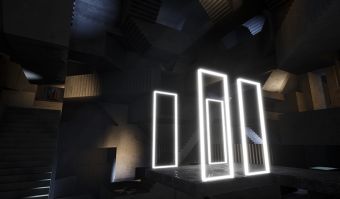
Art can make a world worth living in. After shelter, equality, equity and a healthy planet, there is art. Audience Labs explores possible futures through art—we aim to construct shared experiences and transformative moments that enrich people’s lives.At a time when we’re all struggling with what the future holds, we wanted to bring makers and audiences together to imagine a shared future, reflecting collectively on: Where shall we go? How do we want to feel? What do we want the world to look like? We are interested in expanding where culture takes place, and broadening who it is for, who gets to make it and how it interacts with other agents of connection and change in the world in the Next Renaissance
As Audience Labs is starting its time at King’s College London, we will be working with a network of industry experts, collaborators and experts to focus on critical questions surrounding the future of performance.
Picture left: Current, Rising CGI Production Shot House of Subconscious, Copyright: Joanna Scotcher & Figment Productions
The work will focus on four strands:
1. Artistic Futures—how do we make good and meaningful art that both explores new opportunities for connection and rising to the challenges of an uncertain world? This includes inclusive international collaboration, remote creative processes, audience and community engagement, and new partnerships.
2. Cultural Metaverses—exploration of technical infrastructures needed to create and deliver a distributed cultural experience, including distribution models, and digital dissemination, expansive audience engagement and business models.
3. Ethics, Audiences, Diversity and Inclusion. As we move towards new possible futures for art and culture in a hybrid age, we need to support work that promotes a more equitable ethical world for all.
4. Towards a Net Zero Profile. We will explore the use of digital and physical green innovations that promote reduced travel and touring, and will support the development of low/no impact stages, and the green venues of the future.
Initially, in this new context at King’s, we will take the opportunity to convene a wider ecosystem of artists and cultural organisations, technology partners, researchers and students to explore these questions and lay out possible methodologies and projects to start that journey. A practical plan on how we work together to innovate and make great art with ethics, equity and inclusion at the heart.
We don’t have all the answers yet. I see the role of Audience Labs as a place that combines conversations with practical artistic production—an intersection that a Next Renaissance cannot do without. Audience Labs might well be understood as a Renaissance sandbox in exploring and R&D-ing how culture can help understand the ethical side of technology, how culture can push the envelope.
Innovation is constant iteration, a form of continuous thinking, trying and pushing. Artists and arts institutions need partners that share their civic values to enable innovation. Only in value-based and wide-ranging partnerships can the arts create value, change and equity for audiences and communities everywhere: a societal Gesamtkunstwerk or in other words, social cohesion in the transformations ahead of us.
Picture right: Current Rising – set design by Jo Scotcher, Copyright: Johan Persson
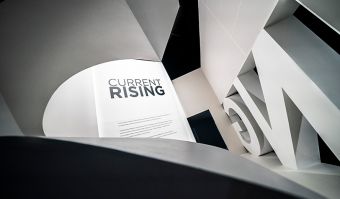
Annette Mees
Annette Mees is an award-winning immersive theatre director known for her innovative, interdisciplinary, experiential work that allows audiences to explore big ideas and meaningful change. She is the Artistic Director of Audience Labs; a hub for imagination exploring new forms of theatre and technology to dream up sustainable, diverse and equitable futures. It connects artists, technologists, researchers, experts, communities to spark new thinking. We use centuries of stage craft and the possibilities of cutting-edge technologies to create spaces for radical imagination, emotional connections and collective experiences. Audience Labs started at the Royal Opera House and recently moved to King’s College London to explore the underlying questions emerging around these new forms. We want encourage work by interdisciplinary, diverse and inclusive partnerships that is driven by imagination and equity, works towards net-zero and uses technological possibilities ethically. Next to that she works as an innovation strategist, artistic advisor and dramaturg for a range of organisations and projects. Currently she is the chair of FutureEverything, a co-host of global conversation around the future of culture supported by Arup and Therme, an artist mentor for CPH:DOX and developing a strategic R&D project with Substrakt.
Picture © Annette Mees
